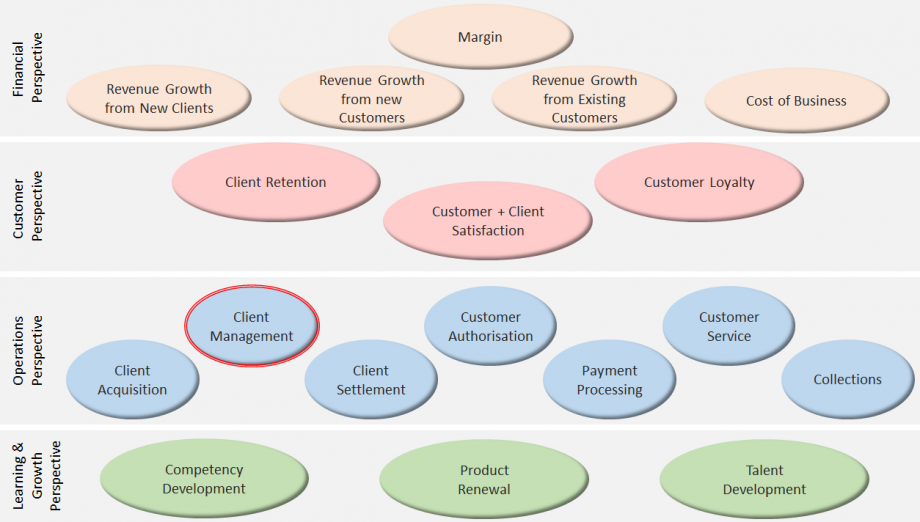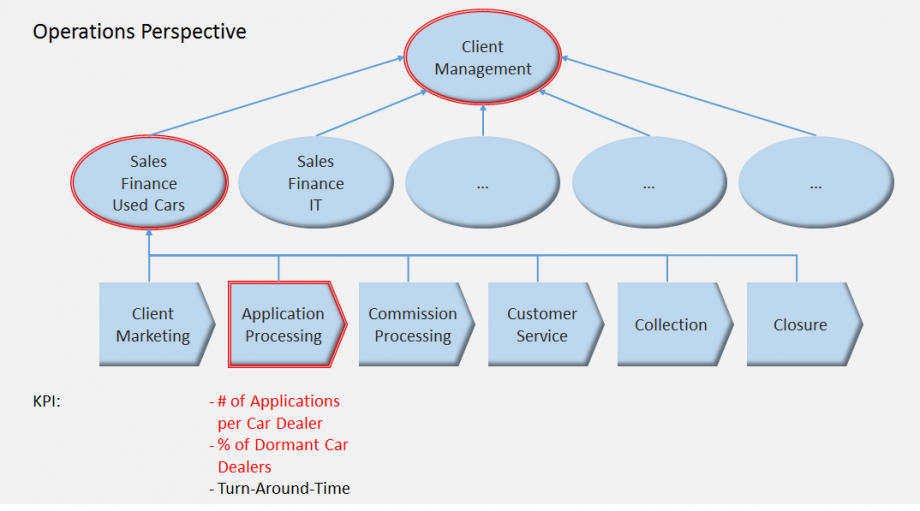Whenever I entered the management team meeting at MyBank, I had my state-of-the-art PowerPoint pitch showing the performance of each department and its core processes as part of our dashboard. Every month, we got the latest underlying data together, aggregated them and displayed an overall dashboard of how the business was doing. With that, we had a clear Line-of-Sight.
For this particular month, my dashboard highlighted only one indicator pointing south, i.e. showing a significant decrease in performance. The traffic red highlighted “Client Management” (Figure 1). Client Management is the business unit that handles our relationship with dealers and retailers in the different industries. They issue our loans for Sales Financing.

Figure 1: Balanced Score Card of MyBank
Gerald, Director Sales Finance was able to shed some light on the significant drop in performance. Drilling down step by step from Client Management via Sales Finance and Used Car Financing he concluded that the indicator for Dormant Car Dealers went up (Figure 2). This meant that the percentage of Car Dealers who are on contract but do not generate loan requests for more than three months, went into a red zone. The initial root cause analysis failed to reveal any obvious reasons for the change. Though, he and his team decided to start a multi-disciplinary project on the underlying process in order to get the Car Loan business back on track.

Figure 2: Driver Tree for Client Management
Getting a Balanced Perspective with a Line-of-Sight
Having a clear understanding of the health status of the organisation is an important leadership task. It involves managers at all levels. The health of the organisation, as many companies knew even before Kaplan and Norton emphasised, is not only apparent in its financials. Following Kaplan and Norton’s Balanced Scorecard, it is visible in a Customer Perspective, an Operations Perspective, a Learning and Growth Perspective and – of course in the Financial Perspective. Whereas the Financial Perspective involves merely lagging indicators, i.e. indicators like revenue, costs and margin that show the result after product or service have met the customer, the Customer Perspective leaves some room for reacting on customer feedback before the financials turn red.
However, the objective should be to identify the drivers for customer satisfaction and consequentially for financial results. These drivers are usually visible in process performance and in the organisation’s capability to learn and evolve fast, long before customer satisfaction or even financials show signs for concern. Therefore, a dashboard is necessary to display timely data of all relevant drivers for the business in a regular manner enabling the managers at different levels to control and improve if necessary.
Everything in a company happens in processes. Hence, process measures are the key indicators that help steering any organisation to success. Process measures help to establish a line-of-sight for the management.
Why Dashboards?
Whether your organisation has a Balanced Scorecard or not is secondary. The vital question is: Is there a set of business relevant measures or a dashboard, which management can use to control the business? Does management have a clear line-of-sight?
We often say, “What gets measured gets done.” This is not entirely true. Look around in your organisation and see how much data your staff collects. How much of it do you analyse and how much do you really use to derive actions? And, even if there are actions, how many of the interventions are really appropriate, i.e. statistically reinforced?
Dashboards serve purposes such as
- Raising awareness for some key indicators among managers and employees. This alone leads to some initial improvements – due to the Hawthorne Effect,
- Building a cause-and-effect mind-set, especially in the process of constructing the driver tree. This driver tree shows leading indicators that drive lagging indicators and serves to give a clear line-of-sight to the process owners. They will be able to see – and often quantify – the impact of their performance on customers and financials,
- Creating appreciation for simple statistical principles like control charts. They are used to identify the appropriate action in case the dashboard shows signals.
How to Develop Dashboards?
Building dashboards is not a one-off exercise but a recurring task that mirrors changes in the organisation as well as learnings out of the dashboard itself. It usually takes the following steps:
Preparing the Dashboard
- Collecting existing indicators that make the initial driver tree. Some organisations are data rich, some are not. Building an inventory of the existing data is necessary – and often full of surprises. Not many businesses use this data in a driver tree with established cause-and-effect relationship. More often than not, the selection of KPIs is based on gut feel fed by a good portion of business knowledge. Almost always, it is necessary to amend the set of indicators after inventorying and evaluating them.
- Designing the dashboard for different levels is a rather creative activity. It involves decisions about which indicators to bring to whose awareness, how to show these indicators and how to set thresholds. Rule of thumb: not more than 10 to 12 indicators in one dashboard.
- Setting up the data collection system is a vital task. The quality of the data in the system determines the quality of information obtained and decisions made. Therefore, the data collection system should ensure that the right amount of relevant and representative data is available. Evaluating repeatability and reproducibility of the data collection system might be necessary.
Using the Dashboard
- Making the dashboard operational is about change and needs proper change management. It usually takes time, training, motivation and a great deal of role modelling by the leadership team to establish dashboards and the right mentality in using them. Start with the obvious indicators that are neither doubtful nor difficult.
- Revising the metrics is an ongoing task that should be part of the annual or bi-annual planning process. It needs time and some trial-and-error to establish effective dashboards showing numbers that really correlate with customer satisfaction and business success.
Conclusion
Building dashboards is a project itself. Their ongoing review and adjustment is as important as changing strategy or processes. Reading business indicators is a management task that requires preparation, focus and the willingness to embrace cultural change. Using dashboards combined with effective data analytics, process management and appropriate process improvement interventions are powerful in steering the business and in ensuring the organisation’s continuous learning and renewal. An effective dashboard with appropriate indicators gives the management a clear line-of-sight to the business objectives.
The project at MyBank did not take too much time. It revealed some obvious drawbacks in our processes. Firstly, our new conditions, i.e. better interest rates have not been communicated to all dealers. Hence, they used other banks for financing sales. The root cause was found to be a mismatch of our car dealer database with the marketing database. Marketing was working with “old” data. Secondly, our sales reps tended to call car dealers whom they are comfortable with.
This means they mostly called car dealers who were active anyway. For both process problems, corrective actions were introduced and monitored. As a result, Gerald’s dashboard has been amended to show the car dealers who have not been contacted for a certain period. This was a leading indicator that was very helpful in keeping current with the status of our communication with our car dealers – long before the relationship could turn sour.
Uwe H Kaufmann: Managing with Dashboards. Rath & Strong’s Six Sigma Leadership Handbook, John Wiley & Sons, 2003

